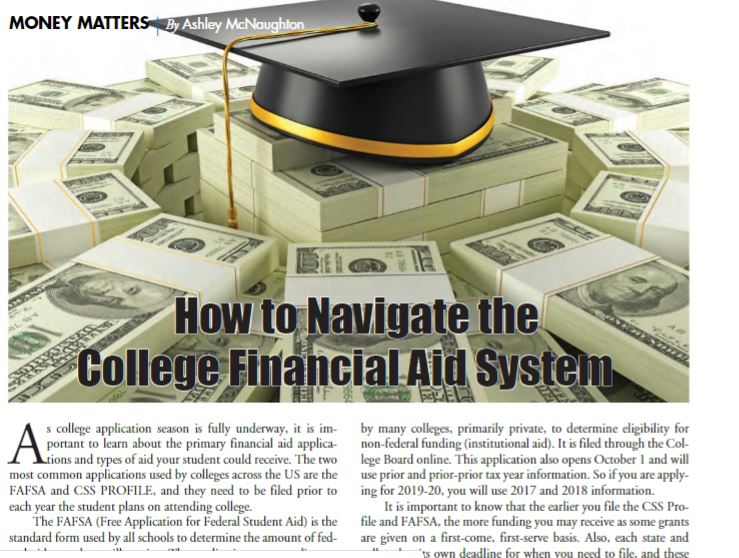What Comes Next?
After applications are submitted and the giant feeling of relief has subsided, most students begin to wonder what to do next. Each school has their own timeline for when they will inform applicants of their admissions decision. In general, schools which have rolling admissions take 2-3 weeks, schools with Nov. 1 EA will inform you between mid December and end of January, and schools with RD in January will inform you by end of February or March. So what do you while you wait?
After applications are submitted and the giant feeling of relief has subsided, most students begin to wonder what to do next. Each school has their own timeline for when they will inform applicants of their admissions decision. In general, schools which have rolling admissions take 2-3 weeks, schools with Nov. 1 EA will inform you between mid December and end of January, and schools with RD in January will inform you by end of February or March. So what do you do while you wait?
Most schools give applicants an account on their website for you to be able to login and check the status of your application. Make sure you have logged in and checked that the colleges have received all of your application requirements. While doing this, keep in mind that it may take some time for the websites to be updated as colleges are inundated with materials around their deadlines. If about a week after the deadline you still see that your application is missing something, follow up with the admissions office to find out what to do. Although some colleges will send you a friendly reminder that something is missing, you do not want to rely on that.
If you do indeed find out that something is missing, do not overreact. Remember, with so many documents and emails being sent back and forth during such a short time span, it is very easy for something to get lost in the shuffle. If what is missing can be taken care of by you, do it right away. If it is something a counselor, teacher, or testing agency should have taken care of, politely follow up with them yourself. Whatever it may be, respectfully ask them to resend the materials as soon as they can. Confirm with the admissions office that you have taken care of it and verify if they have received the missing materials. While doing all of this, it is important that you advocate for yourself and be patient. Admissions would much rather hear from the students themselves than from a parent or counselor. You want to show them you are ready for college right?
It should go without saying, but keep working hard and maintaining or improving your grades. Colleges ask for mid and final reports from your counselor for a reason! If you are given admission to a college and your grades sink, they have the right to revoke their offer. On the other hand, if you end up getting deferred or waitlisted, you want to be able to show progress to improve your chances of acceptance. No matter what your situation is, continuing to work hard and get good grades can only help.
Now try to relax and wait for your admissions decisions to roll in! Remember, there is a school for everyone and it will work out. Stay tuned for my next article on what to do if you are waitlisted or deferred and how to weigh your options.
Good Reads:
Article on the FAFSA and CSS Profile
As college application season is fully underway, it is important to learn about the primary financial aid applications and types of aid your student could receive. The two most common applications used by colleges across the US are the FAFSA and CSS PROFILE, and they need to be filed prior to each year the student plans on attending college.
Locals can pick up the newest edition of the free Neapolitan Family magazine at various locations in Naples. On page 44 you will find my article all about the FAFSA and CSS Profile. You can also read it online now. Get those financial aid applications in ASAP!
All About the FAFSA
The FAFSA (Free Application for Federal Student Aid) is the standard form used by all schools to determine the amount of federal aid a student will receive. The application opens on October 1 each year and closes the following June 30. The FAFSA calculates the EFC (Expected Family Contribution), what the government considers a reasonable amount the family should be able to contribute to the student's educational costs whether or not a parent wants to contribute to their child's education.
The FAFSA (Free Application for Federal Student Aid) is the standard form used by all schools to determine the amount of federal aid a student will receive. The application opens on October 1 each year and closes the following June 30. The FAFSA calculates the EFC (Expected Family Contribution), what the government considers a reasonable amount the family should be able to contribute to the student's educational costs whether or not a parent wants to contribute to their child's education.
It is important to know that the earlier you file, the more funding you may receive as some grants are given on a first come, first serve basis. Also, each state and college has their own deadline for when you need to file, and these often fall around the time the college applications are due. While the FAFSA is primarily used to determine federal funding, some schools also use it to determine the distribution of their own institutional aid. Therefore, it is often recommended that all students fill out the FAFSA and do it early, whether or not they think they will be eligible for federal aid.
The FAFSA needs to be filed prior to each year the student plans on attending college. It is completed using prior-prior tax year data for the student and parent(s). So if you are filling it out for the 2019-2020 school year, you will use 2017 tax information. If you have not filed your taxes, you can estimate your income and update the application as needed. Before you begin, it is helpful to gather the materials you will need to complete the application:
An FSA ID to sign electronically (you can apply for this special username and password online via fsaid.ed.gov or other U.S. Department of Education websites and the student and one parent, the custodial, for each dependent will need separate IDs)
Your Social Security Number
Your Federal Income Tax Returns, W-2s, and other records of income earned (Note: You may be able to use the FAFSA's IRS Data Retrieval Tool which transfers the data directly from your completed tax returns to your application)
Bank statements and records of investments (if applicable)
Records of untaxed income such as child support or interest income
List of schools you are applying to
Ensure that the information you have entered is accurate and complete to prevent any delays in the processing of your application. Make sure you have added any schools to which you are considering applying to the FAFSA application so that they receive the information. If any financials need adjusted or schools need added, you can go back in and update the application later. If your family's financial situation has changed for the current year and the tax information you must use for the application does not properly reflect it, it is important that you contact each of the colleges and inform them of your current situation.
Tips for the Common Application
As college application season is fully underway, it is time for some tips for jump-starting your applications and filling out the Common Application.
As college application season is fully underway, it is time for some tips for jump-starting your applications and filling out the Common Application:
Once you have created your Common App account, search for and add your colleges to your list via the search tab.
Create a timeline with all relevant application deadlines for each school to keep you on task. Include personal deadlines for completing the essays and other materials you will be submitting.
Make an essay chart which includes all essay requirements for each school along with the wordcount limits. Begin drafting your essays as soon as possible to give yourself time for several rounds of editing. Set an early deadline for essays to keep yourself on time for all applications.
Make a designated application folder and gather all documents and information needed for the Common Application. Take a look at the quick guide below to get an idea of what information you will need to complete the app. By gathering materials needed such as your transcript, counselor and teacher contact info, resume, and testing information before you begin, you will save yourself time and stress while you are in the middle of it. If you do not have a resume, now is a great time to put one together for future use.
Formally ask your recommenders in person to write their letters before inputting their contact information and sending the request via Common App. For more tips about that, check out my previous post here: http://acmcollegeconsulting.com/the-recommendation-letter-2/
Before you submit your application, please follow up with your teachers and counselors to ensure they will be able to complete and submit a recommendation prior to the school’s stated application deadline. You will not be able to make changes to the teacher/counselor list after you submit your application, you will only have the option of re-sending the notification to your teacher or counselor.When entering your activities, list them in order of importance. You can use the arrows to rearrange them. You have the space to include 10 activities with a description of up to 150 characters not including the 50 character title/role section. You may need to be creative to fit a decent description into such limited space. You can use easily understandable abbreviations and incomplete sentences, but do not use acronyms. Use active verbs and try to include details which demonstrate your affect on the organization such as factual results. Whatever you do, be consistent with the formatting you are using for listing each activity. Just because there are 10 spaces for activities, do not feel the need to fill them. However, if you do happen to have more than 10 substantial activities, you can use the additional information section to include others. Do not do this unless the activities are truly meaningful. Your application readers will know the difference between something significant and fluff.
Invite your counselor, consultant or a mentor to serve as an Advisor for your Common App. You can add them under the Recommenders and FERPA section for your colleges by using their email address. This will allow them to login and view an outline of your application. It is great to have someone else look over everything you entered and make suggestions for optimizing your activity descriptions, etc. Note that the Advisor will not be able to edit or submit anything on your behalf and colleges will not be able to see them.
Make a copy of materials submitted and take screenshots of submission verifications in case data is lost or somehow received late. Believe it or not, these screenshots have played an important role in discussions of timely submission of applications with colleges.
How to Choose Your High School Courses
When deciding between the courses offered by your high school, you will likely have many questions about what is best. Making better decisions earlier along the high school pathway can lead to a more balanced, stronger transcript for applying to college. Here are 4 guidelines to keep in mind when choosing high school courses. While there may not always be a clear path, particularly during the earlier years, following these guidelines will certainly help.
When deciding between the courses offered by your high school, you will likely have many questions about what is best. Making better decisions earlier along the high school pathway can lead to a more balanced, stronger transcript for applying to college. Here are 4 guidelines to keep in mind when choosing high school courses. While there may not always be a clear path, particularly during the earlier years, following these guidelines will certainly help.
Challenge Yourself- You should take courses in which you know you will be both challenged and successful. Curriculum choice should never be based solely on getting the highest GPA. By choosing higher level courses, you are effectively preparing yourself for the rigor of college and demonstrating that you are ready. Application readers take into consideration what level of classes were available to students and will certainly take notice if it seems that a student was being 'lazy' and/or not challenging themselves.
Balance Your Schedule – You should balance your curriculum strength from year to year and refrain from taking all advanced courses one year and none the next. Students who overload on challenging classes risk overextending themselves and thus not getting the grades they would have otherwise been able to obtain. It is also important for you to remember that senior year counts although courses will not be completed before application time. Colleges want to see that you are consistently challenging yourself and almost all colleges will look at mid year and final grades for seniors.
Meet College Requirements - While you most likely have not made your college choices before senior year, there are basic core requirements which almost every school has for freshman applicants. You should keep these in mind early on so that you are able to fulfill the requirements by graduation.
Follow your Interests – If you are particularly interested in a certain subject, college major or career, you should take some stronger courses in subjects related to those. Not only does this allow you to pursue your own interests or passions, it also strengthens your case for admission to certain college majors and/or programs. For example, if a student wants to go into engineering, they should focus on taking stronger science and math courses. It is important to keep in mind that you should not neglect to take your core subjects in pursuit of those electives which interest you more, but you can certainly replace the less important classes with them.
Whether it is an IB program, AP courses, AICE, Dual Enrollment or something else offered by your high school, you should thoroughly consider your options and choose a path which will allow you to be both successful and challenged. Remember that if your high school does not offer courses which challenge you enough or interest you, there are always other options to consider such as local community college courses, online courses or self studying for AP exams. If you have additional questions, do not hesitate to schedule a time to sit down with your high school guidance counselor to go over your options or give a college admissions office a call.
Some examples of college admissions requirements and tips for course selection:
The Recommendation Letter
The importance of the recommendation letter and how to request them.
In the most recent NACAC State of College Admissions report, more than 50% of the colleges responded that the teacher and counselor recommendations were of moderate or considerable importance in their admissions decisions. In basic terms, this means the recommendation letters are nothing to shrug off. As with the essays, this is another way for students set themselves apart from the ‘competition’ and give the reader more details about who they are.
Each college has different specifications for how many recommendation letters they require, recommend or will accept. Typically they require one from a counselor and at least one from a teacher. Students need to be sure to fulfill these requirements and ask the proper people. If a letter from a teacher is required, it should be a teacher from their school, preferably from a core subject. Students should only submit supplemental letters from recommenders connected to an extracurricular activity or something outside of school after they have fulfilled the teacher and counselor recommendation requirements and even then, only if the college accepts 'others'.
It is important for students to ask someone who knows them well and with whom they have had a good relationship. The last thing the admissions office wants to read is another generic letter. If students feel that the teacher or counselor may need more information about them in order to write a detailed letter, they can give the recommender a ‘brag sheet’ or resume with the details of their accomplishments and academic history. This can be a great help for infusing letters with personal details about the student. Note that one detail the recommendation letter should not contain is the names of the other schools to which the student is applying.
A common mistake made during this process is students not giving their recommenders enough time to write a quality letter. Keep in mind that they are most likely writing letters for many other students and will need more than just a few days. I suggest requesting the letters in August to allow plenty of time to meet any of the application deadlines. Students can check the status of the recommendation letters by logging in to whichever application platform they are using, but they will not be able to read them.
Whether it is via Common App, Coalition App, Naviance or another platform the student uses to request recommendations, they should be sure to formally ask their teachers and counselors in person before sending the request online. Not only is this the polite thing to do, it also gives the recommender a chance to ask the student any questions they may have before writing their letter. They will more than likely be happy to hear more about the student's future plans and colleges they are interested in.
Students should begin thinking about their recommendation letters earlier than senior year. If they have someone they think they would like to have write a letter, they can foster that relationship earlier on. Many students even ask for their letters at the end of junior year to give the recommenders more time before the rush of the new school year begins.
Tips for Recommenders:
https://www.insidehighered.com/advice/2016/12/02/how-write-stronger-letters-recommendation-students-essay
For Students:
Demonstrated Interest
A term which is somewhat unknown to many new to the college search and application process has been gaining a lot more attention recently. ‘Demonstrated Interest’ is real and very much alive! Although one can not be certain how much weight it has in the admission decision, it is not something to be brushed aside.
A term which is somewhat unknown to many new to the college search and application process has been gaining a lot more attention recently. 'Demonstrated Interest' is real and very much alive! Although one can not be certain how much weight it has in the admission decision, it is not something to be brushed aside.
In the 2016 NACAC Admission Trends Survey, nearly 40% of the colleges responding rated demonstrated interest to be of moderate or considerate importance in their admissions decisions. Although we can not be certain what that means, we can safely assume that if a student is matched up with a candidate of very similar caliber, having demonstrated interest would give them the advantage.
What is it? It is pretty much all in the name. It is the student showing their interest in their potential colleges. It is the student letting the school know they are considering it. It is a student establishing a relationship with the school. It is the student putting themselves on the school's radar.
Why should you do it? Colleges have a tough decision deciding between thousands of quality applicants and knowing that a student has taken the time to connect with the school and get to know it demonstrates to them that they have a genuine interest. They want to enroll a certain number of students and students who have demonstrated interested are more likely to accept their offers of acceptance. Makes sense, right?
How do you do it? There are many ways to demonstrate interest, most of which will likely occur on their own as you are doing proper research to find which schools are a good fit. Going on campus visits, requesting information, emailing admissions with questions, attending college fairs and speaking to your local admissions representatives, participating in interviews if available, following the schools on social media platforms, and applying to Early Decision or Early Action deadlines are all common and somewhat easy ways to demonstrate interest. When you attend official campus tours, the colleges usually collect your information. If you decide to do your own, be sure to stop in at the admissions office and speak with a representative to get your name on their 'list'.
No need to go crazy emailing admissions on repeat and risk annoying the already extremely busy staff, just do your due diligence with your research and be sure to show the schools you are interested in some love! As always, be real, be YOU.
For more information on this topic listen to Ethan Sawyer, The College Essay Guy in his podcast: https://www.collegeessayguy.com/podcast-stream/demonstrated-interest-how-to-build-authentic-relationships-with-colleges-and-why-its-a-good-idea
Scholarmatch
Last Sunday, I took a crazy red-eye flight home from what was a whirlwind of a trip to San Francisco. I almost spent more time traveling than I did in the actual city, but I used my time well! The purpose of my trip was to attend the Scholarmatch Coach Convening, a day of training and networking for all college coaches volunteering with them this year. It is my first year working with Scholarmatch and I am very excited about their mission.
Last Sunday, I took a crazy red-eye flight home from what was a whirlwind of a trip to San Francisco. I almost spent more time traveling than I did in the actual city, but I used my time well! The purpose of my trip was to attend the Scholarmatch Coach Convening, a day of training and networking for all college coaches volunteering with them this year. It is my first year working with Scholarmatch and I am very excited about their mission. ScholarMatch began in 2010 as a scholarship crowdfunding platform but is now a large organization offering a full range of college access support services to high achieving, low-income students across the country. They have coaches working directly with students at their SF headquarters and offer virtual coaching to all others. Last year they helped over 1500 students and that number will certainly continue to grow. I look forward to working with Scholarmatch and supporting these underserved students on their journey to college and beyond. What amazed me at the convening was the number of exceptional volunteers they have and the amount of excitement and positivity that was radiating from our group. I met a lot of fantastic coaches from across the country and even a few from Europe. We had a great time networking and learning how to best support our students.
In between flights and training, I had a chance to tour the two beautiful campuses of UC Berkeley and University of San Francisco. Berkeley surprised me with the quality of facilities and green space. Although they have 28k under grads, it still has a great campus centered, smaller feel. Add that to the 91% graduation rate and 97% retention rate and I like it even more! University of San Francisco had such a small campus I would not have guessed that they have over 10k students. The views from their original buildings on top of the hill, the Harry Potter-esque library, the beautiful Saint Ignatius Church, and wonderful new Koret Health and Recreation Center are surely loved by all of their students. I am happy I got to see both campuses and learn more about their excellent academics as well.
UnMAZED Magazine
I recently started contributing to a new online magazine called UnMAZED - a teen and parent resource for academic and personal success written by educational experts.
I recently started contributing to a new online magazine called UnMAZED - a teen and parent resource for academic and personal success written by educational experts. Although many of the contributors are from FL, we all provide advice which can be helpful to students and parents across the country. The next few months will be highlighting topics around the college process, with July's issue focusing specifically on advice on campus visits and finding the right fit. Check out the website to subscribe to the newsletter and access articles and other resources from experts dedicated to your student's success!
Parenting Your Child Through the College Application Process
While helping your child search for and apply to college is an exciting time, you are most likely battling both of your feelings of stress and anxiety on the side. Here are several tips to tackle those feelings and help you and your student along the way.
While helping your child search for and apply to college is an exciting time, you are most likely battling both of your feelings of stress and anxiety on the side. Here are several tips to tackle those feelings and help you and your student along the way.
Listen – This process is about your child discovering themselves and their dreams. Although they may not have an exact idea of what they want, you can definitely help them if you only listen. The college search is about finding what fits them, not what fits you. Understand what their strengths are and help them go from there. You may think you know what is best for them, but this is a time for you to listen and learn from your child. Let them direct the search. Ask questions instead of giving answers.
Visit – You may have read my previous post about campus visits, but if you have not, do not underestimate the importance of them. Touring schools gives your student the chance to learn more about what they want from their future college and helps them fine tune their search to schools which are a better match. Go on the tours with them, notice what gets them excited and ask them questions to help them ground their opinions along the way. It is a great time for some family roadtrips!
Do not focus solely on those big names and rankings - If you have Googled schools or discussed them with your friends or peers, chances are the famous (or infamous if you ask most college counselors) U.S. News & World Report rankings have been mentioned. While those lists are undoubtedly filled with great schools, there are thousands more out there worthy of consideration. Those rankings are created using questionable data and leave many important factors out of the picture (read this Washington Post article for more on that). If you only focus on those lists or the big name schools, you are missing out on finding others which may be much better matches for your student. Not only that, you are adding to the anxiety and pressure your student may be feeling to get into one of those schools. You want them to be comfortable with wherever they are accepted, not setting them up for a potential let down.
Teach self advocacy – you can use this time to teach your student to advocate for themselves if they are not already. Once they get to school, you won't be there to call their professors or take them to their doctor's appointments. Let them take ownership of this process and teach them to take care of themselves. If they need something for their applications, let them be the one to ask their counselor or teacher. If they want more information from a college or would like to contest a financial aid award or admissions decision, they need to do this for themselves. In fact, it is viewed poorly when a parent contacts a potential college on behalf of their perfectly capable child. Send them off to college knowing they can take care of themselves!
Last but not least, remember that where your child goes is not a reflection of your parenting success. Yes, you can most likely attribute part of their success in high school to your parenting and support. Yes, you probably had an affect on their decision to go to college and where they are going. However, the school and career path they choose is their own and in no way should you think less of yourself as a parent because of their decision. Your child is becoming an adult and their choices are their own to make. Congratulations on making it this far and enjoy your time left with your child at home!
























